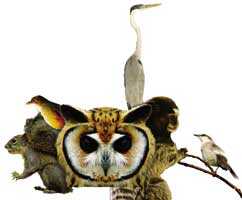
MARCOS KAWALL DE VASCONCELOS /SVMAThrush, Brazilian squirrel, Short-eared Owl, Great Egret, Black-tuft monkey, Masked-water TyrantMARCOS KAWALL DE VASCONCELOS /SVMA
The thousands of streets in the city of São Paulo guard much more wild life than just the white, black or grey pigeons that rest up on the wires of telephone poles and fight for the crumbs of bread on the sidewalks, getting in the way of the hurrying pedestrians. The pigeons are only one of 433 wild animal species that have spread themselves through the sparse greenery of the metropolis, according to a recent survey of the municipality’s fauna, divulged at the beginning of June by the Municipal Secretariat of Greenery and the Environment (SVMA in the Portuguese acronym).
Over a twelve year period the team coordinated by the biologist Anelisa de Almeida Magalhães, from the SVMA’s Fauna Division, found 258 species of birds, 58 of mammals, 2 of crustaceans, 2 of spiders and 40 amphibians in the 48 green areas that resist between the concrete and asphalt of the city. It is probable that the majority of the São Pualo population does not know the difference between a domestic pigeon from the other type of pigeon, the juriti( white tipped dove), nor have noted in the gardens of buildings the thrushes, with their reddish breast and slow and sad song.
But anyone who takes an interest in appreciating the São Paulo wild fauna does not have to leave the city. In Ibirapuera Park, the best known and one of the largest in the capital, there are 142 species of birds, from the most easily identifiable such as the Great Egret (Ardea alba) and the noisy Southern Lapwing (Vanellus chilensis) to the rarest such as the Blond-crested Woodpecker (Celeus flavescens) or the Red-crested Cardinal (Paroaria coronata), with its elegant red forelock. Among the 134 species that inhabit the Carmo Park, in the Eastern Zone of the capital, live the Whistling Heron (Syrigma sibilatrix), with its bluish face and grayish back, the White-faced Whistling Duck (Dendrocygna viduata) and the Striped Owl (Rhinoptynx clamator), as well as another 114 species of birds.
With a little luck the visitor can even encounter the Brazilian Squirrel (Sciurus ingrami), the national version of the squirrels of the Northern Hemisphere, or even a Grey Brocket Deer (Mazama gouazoubira), today under threat of extinction. In the extreme south of the metropolis, where the buildings and house do not as yet impose themselves completely over the natural vegetation, the team, led by Anelisa, found traces of a much larger mammal: the feared cougar or puma (Puma concolor capricornensis), also under the risk of disappearing from nature.
It is not by chance that the birds are the most abundant group, found even where the concentration of buildings is high and the greenery does not go beyond suave dabs on the scenario. A comparison between the birds of ten parks in the capital brings up an explanation. The predominant species in these areas are the least demanding in relation to the type of food available: they eat fruit and seeds as well as insects. “In these ten parks 60% of the species eat a very varied diet, a fact that can favor their adaptation to the environment that has been modified by human presence” says biologist Marina Somenzari, the study’s author.
More than just guiding the glances of the São Paulo citizens among the tree lines parks of the capital, the survey of the municipality’s wild fauna should help the work of the SVMA’s biologists and veterinarians. In the end, it is the secretariat that administers the principal fist aid station for the wild fauna of Sao Paulo: the Manequinho Lopes Nursery, protected within an area of restricted access in Ibirapuera Park, where the red howler monkey, named Binha, and another 23 companions of reddish brown fur are spending some time whilst they await the moment of returning to nature. “This inventory is fundamental to guide the re-introduction of these animal into their natural environment” says Vilma Geraldi, the Secretariat’s Fauna Division director, who administers the nursery, whose name pays homage to the municipal worker Manuel Lopes de Oliveira, who during the decade of the 1920s planted hundreds of eucalyptus trees in Ibirapuera in order to drain the swampy land and to allow for the creation of the Park.
Here every month around 170 animals arrive – red howler monkeys, tamarins, canaries, tortoises, among others – brought in by the population, by firemen or rescued by forestry policemen in operations to combat wild animal trafficking. Last year, only in the state of Sao Paulo 30,000 wild animals were apprehended, a population ten times greater than the Sao Paulo Zoo, the largest in Latin America.
“In order to return these animals to the wild to which they belong, it’s firstly necessary to know how the different species distribute themselves through the Sao Paulo green areas” explains Anelisa, who for some 12 years has been working on the identification of the municipality’s wild fauna, a task that did not end with the publication of the inventory.
Republish